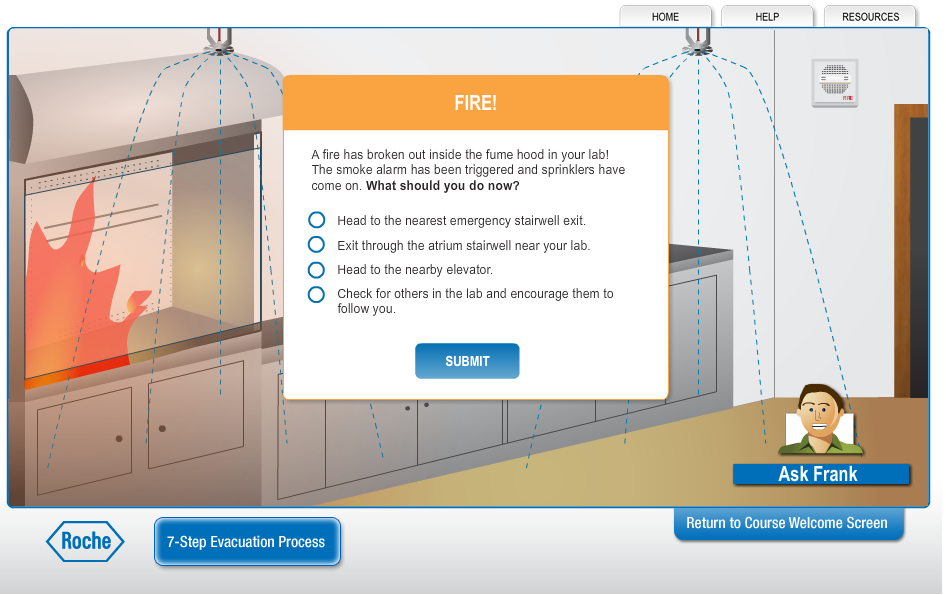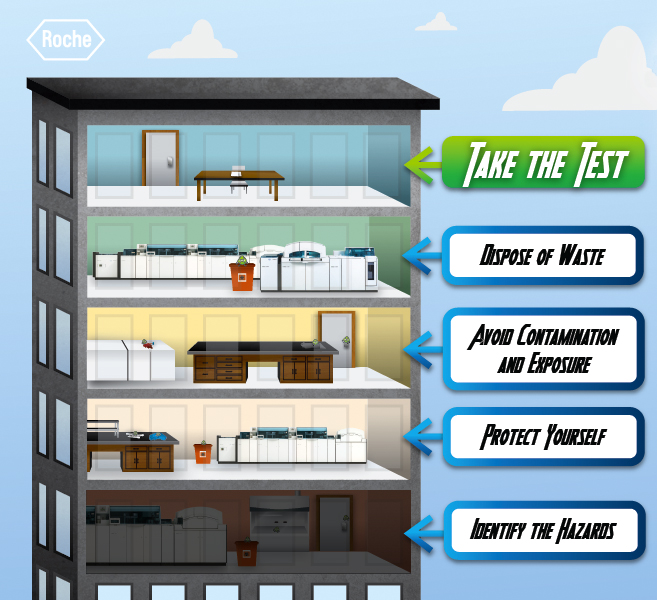
Why invest in eLearning courses instead of “flat” media like PowerPoints and webinars? The interactivity, of course. Besides the obvious benefits—reduced costs and a increased accessibility—eLearning allows learners to practice safely through a variety of interactions.
I interviewed Sharon Boller, President of Bottom-Line Performance, to compile a list of effective eLearning interactions. This list is a great starting point for structuring content that really helps change attitudes and behaviors.
According to Sharon, the main challenge is to think of an interaction as something that mentally engages the learner—not just stuff they can click on. If you can help people begin the mental exercise of pondering something, you’re on the right track.
Let’s look at the five interaction types Sharon identified for eLearning.
Scenarios
Scenarios are perhaps the broadest category, and the most commonly used eLearning interaction type. Most eLearning courses will have at least one section with scenarios. Many of the courses we design are entirely scenario-driven. Sharon identified three main types.
“What Would You Do?” Scenarios
Present a scenario, either with a simple paragraph of text or text and an image. Then, ask the question: “What would you do?” Leave a blank field that learners can type into, then let them compare their response to a suggested response after submitting. It’s simple and effective to ask people this, you don’t need fancy graphic design or programming skills to use this interaction.
Multiple Choice Scenarios (No branching)
Multiple choice questions hold many benefits for eLearning. First off, you can capture the data and easily score it. Multiple choice questions are more realistic than we’d like to think. Sharon pointed out that “life is a series of multiple choice questions.” Feel free to make liberal use of scenarios driven by multiple choice questions in your eLearning.
To control the complexity and cost of your scenario, only design for the series of correct responses. Then simply write feedback for the incorrect responses. If learners choose an incorrect option, they see feedback explaining what they should have chosen before moving on. While you lose some of the opportunity for learners to see consequences and learn from mistakes, scenarios like this are much simpler to build from a programming and design standpoint. Try this interaction if you don’t have skill or ability to do a branching scenario.
Branching Scenarios
The biggest opportunity for learning from mistakes in eLearning comes from branching scenarios. Let learners go down the wrong path for awhile and see where it gets them; they’ll appreciate the ability to see a realistic range of possibilities.
The key to a successful branching scenario is to keep most branches limited to two choices. This will limit the complexity. As you can see from the screenshot above, every decision does not need to be limited to two choices. The trick is to control the length of your scenario as you go, making sure it doesn’t creep outside of your scope.
The Building Evacuation course we built for s Fortune 500 client is a branching scenario from start to finish. We kept the course within a tight budget by limiting how far each branch could go; incorrect responses only continued for two more choices before ending. Try this approach when you need to include more than two options, but still want to limit the complexity.
See the course for yourself here.
Q&A… with a “success” meter
Questions and answers are a common feature of eLearning courses, especially in the form of a post-test. Why not include a meter that shows learners how their performance affects their job success, or the success of their organization?
The example below is a sales meter found in the Formulation Type Matters eLearning game we developed for Dow AgroSciences. Players answer customer questions, and their overall sales increase or decrease based on their results.
Other courses we’ve built include a meter showing learner performance compared to a competitor. Based on their ability to respond to questions, learners gained or lost market share for the company. This interaction allows you to use a simple Q&A approach, but show how the results are tied to the success of the company. Learners like this approach because the feedback is presented in terms of a real-world consequence. Sharon noted that creating any type of consequence besides right or wrong helps make the connection with why learners’ actions matter.
Getting Advice from Characters
Use of characters and learning agents is common practice for instructional designers. Giving learners the ability to ask for help from various characters in the course works well as an interaction.
In the Healthy Families course we designed for the Indiana School of Nursing, we scripted out characters who represented different points of view someone might commonly go to. One was a co-worker, one was a boss. While considering options, learners could listen to 30 second sound bytes from a co-worker, listen to a boss share their perception. Learners would consider both pieces of advice… some of it good and some of it less valuable. Use an interaction like this to encourage the mindset of talking to other people or consulting a resource to gain information.
“Day in the Life” Calendars
Whenever possible, learning interactions should help mirror the conditions and decisions learners face on their jobs. Another interaction Sharon liked in the Healthy Families course was the ability to access the “day calendar” for the learner’s job role. By simply clicking the calendar and seeing a typical daily schedule, this interaction sets context at the start about why information in the course even matters.
Explorable Environments, Intriguing Visuals
When learners are not choosing their response in an eLearning scenario, they are often exploring an environment. A typical “exploration” interaction involves hovering over various things and learning what they are, and the key is to make the environment relevant, and the visuals compelling. If you have access to a graphic designer but no programmer, you can get a long way by designing a great graphic learners will want to look at and explore, without needing to include advanced programming features.
Summary
Throughout all of these eLearning interactions, Sharon recommends thinking in terms of “choose your own adventure.” Continuously putting people in the mindset of “what would you do?”, while creating some sort of real-world stake to make people feel vested. While some of these interactions obviously require some programming and design support, you can get started on most of them with even the most basic of authoring tools.
Need some help designing your eLearning course? Contact us.






